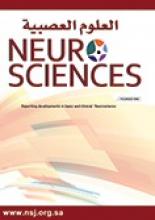Abstract
OBJECTIVE: To identify high risk groups for the development of convulsive status epilepticus (CSE) in an attempt to decrease the incidence and to determine both the time to access to medical care and the use of prehospital treatment in an attempt to reduce the duration of seizing.
METHODS: Retrospective study record analysis of all cases of CSE in children, at the King Abdul-Aziz University Hospital, Jeddah, Kingdom of Saudi Arabia from June 1997 to June 2000.
RESULTS: During the study period there were 24 cases of CSE. The major etiologic factors were chronic neurological disorders, idiopathic epilepsy, and acute cerebral insults. All but one of the chronic epileptics in the study group had at least one identifiable risk factor for the evolution of breakthrough seizures into status epilepticus (SE). Mortality was 12.5% and chronic neuro-behavioral morbidity in previously normal children was 17%. The average total duration of seizing was 2.3 hours, with an average of 52 minutes prior to arrival in the hospital. Prehospital rectal diazepam was administered by the family in only 2 instances, and in both cases the patients were overdosed.
CONCLUSION: The identification of risk factors for CSE can serve 2 purposes: Focus targeted patient and family education, and a checklist for emergency room personnel to recognize those presenting with breakthrough seizures who are susceptible to SE, aiding in management decision making. The incidence of SE can be reduced by abbreviating the duration of breakthrough seizures. This can be achieved both by more widespread yet proper use of rectal diazepam at home, and by auditing the process of patient or family education.
- Copyright: © Neurosciences
Neurosciences is an Open Access journal and articles published are distributed under the terms of the Creative Commons Attribution-NonCommercial License (CC BY-NC). Readers may copy, distribute, and display the work for non-commercial purposes with the proper citation of the original work.






